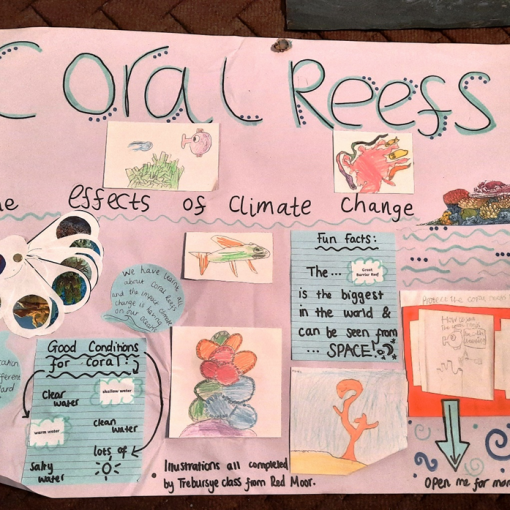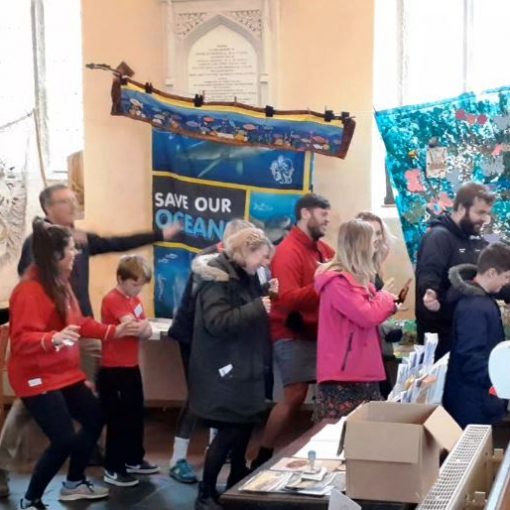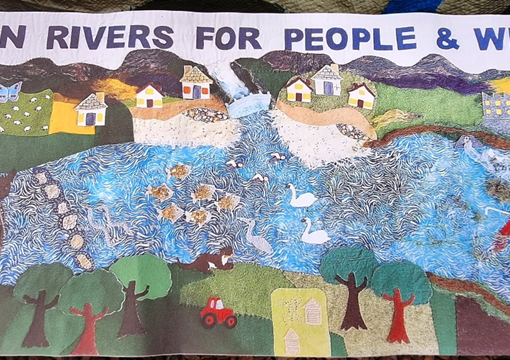23rd March
From the first striking of a match to the conclusion in 5 days time, this week I describe the journey to a Ceremony of Climate Hope, the challenges and ways that the light is spreading!
The story began in December 2021, as I observed the congregation, from my distant place on the organ bench in Lanlivery Church. Families of young children were packed together, excited by the activity of lighting a candle on an orange. And even better, they got lots of sweets on the top. Did they take much notice of the words? Did they grasp the meaning? Not a bit. Both text and music elements were really alien to them; complex adult words and a very off-putting unknown song.
Somewhere deep in the middle of the service was a section where the orange is compared to our planet. For Christian purposes it has a red cord or ribbon around, which – along with the sweets – are representative of the blood and body of Christ. Not being a Christian, I found that slightly gruesome and as it is in my nature to ‘think outside the box’, at once I imagined replacing the red colour with green and blue. This could more realistically represent our world.


The year 2021 ended and I knew I had to start work in January 22, or the germ of an idea would not develop – the first match had been lit! By the autumn the songs were written and I had recruited a fellow musician and retired teacher, Joe Monks, to help with recording in a studio near Bodmin. Joe, who played accordion, was amazed by how Chris (studio manager) and I worked together. I sang and did other bits and bobs on keyboard, hand bell, drums etc. Gradually, as we worked to edit the main song, words were improved, actions suitable for children were visualised and the whole concept of ‘sharing the light’ came together. Instead of lighting candles for everyone, we would connect 2 people or organisations and ask them to take time, wait until the light transfers from one to the other and in this way they would pledge to connect and do what they can for our planet, in response to the climate emergency.
Running up to Christmas 2022 I put in a few hundred hours to create what eventually will be known as ‘Recipe Books’ for a Ceremony of Climate Hope. All will be revamped, over the summer of 2023, leading to publication (hopefully) of a book of Main Ingredients – words, songs and sheet music for instruments, and a 2nd book of recipes, where the materials are designed to help a teacher plan and deliver a Ceremony of their own. At this point, the link with Christianity became thin, and eventually disappeared altogether, so that there would be no limit on scheduling at any time, any place in the world and with a faith, or none.


The journey continued and gradually more and more people came on board. The final essential element we needed was a school, willing to try out the new concept. I sent an email attaching the Recipe Books, to about 6 schools locally, addressing them as ‘Nearest and Dearest’ to The Meadow Barns and asking simply, is anyone up for giving this a try?
Red Moor School jumped at this opportunity, without hesitation. They already had a strong commitment to sustainability and status as an Eco school, which I mentioned in the blog of September 2021.

I am a very honest person, to the extent of being far too blunt sometimes. So I will acknowledge now that I was taken aback, when I realised what a very different Ceremony this would have to be, working with 53 boys and 2 girls, who never gather together in a school hall for singing, who always achieve their learning and development in very small groups, or individually with their adult helper. Everything is student-centred and self-directed.
With agreement between myself and Mike Abbott, Assistant Head Teacher, we commenced operations with me attending a meeting of the School Council. They had chosen 3 main topics from the ‘Recipe Books’ – drought and flood, oceans and plastics and rain forests. Their geographic areas of interest were Cornwall (drought 2022), Australasia (oceans and corals) and the Amazon. By the time of our meeting I was convinced we must add Africa and possibly Costa Rica to this show. I have been to Kenya and have connections there already. I studied dance and drumming and gave school performances with a band from Zimbabwe. Our Meadow Barns resident artist has created 3 wonderful, vivid wall-hangings for a past event … it was obviously the way to go and luckily I won over those first students by showing them the fun to be had with the dance.

And so we went ahead and have now completed 5 afternoon sessions, short in duration (40 mins max); the dress rehearsal will be session 6. Every lesson has involved a new combination of staff and students, you never know what is coming through the door! Being used to so much structure in mainstream schools, I was thrown initially by this, but looking back I believe my own usual creative way of working has matched theirs very well. Focus on fun, make it up as you go along. Keep laughing and you can inspire someone, like Mike, who began saying ‘I will never be involved in the Creative side and you won’t catch me dancing’. Last week, he did the dance and became very good within about 10 minutes. 😊 I want to thank all of the staff so much, for responding in the positive way they have.
I look forward enormously to setting up the church on Monday evening, with all the wall hangings going up and seeing the films the students have made, on Tuesday. In the end they didn’t quite make it for creating the Ocean and Rain Forest back-drops. For the Oceans I already had a wonderful short tapestry, made by Par Creative Workshop during lockdowns of 2020. To cover the lower area, I gave in and bought a suitable option, a National Geographic duvet cover made from recycled plastics.



For the Rain Forest, at the last moment, Bodmin College Greenfield Unit dived in (literally). They had an old sheet from me, poured green paint into big trays and invited the young people to paddle! Each one stepped onto the material and left their ‘Carbon Footprint’ as a leaf, on one of the Rain Forest trees. What an amazing thing to have come up with! Thank you so much staff at Greenfield for doing this. I am picking it up on Monday and will share the pictures next time.
In my past life as a music teacher, I was employed to run ‘whole class instrumental’ lessons. Memories are still vivid of the nightmare experience, even with a lovely class, blowing on some dreadful plastic C clarinets. The keys kept falling off, the reeds were broken and incapable of making a sound. In that environment I invented a scheme of rewards and sanctions; if you had to colour in a drum stick on the page, it was bad. It meant you had been ‘diddling’ = fiddling with something that made sound, and driving everyone else nuts. If you got anywhere near to 10 sticks filled in, you had to sit out. I asked Mike, should I use this page? He said, I think not … and he was right. But I gave out stars anyway!

The Red Moor students never ever ‘diddled’. They were so respectful and quickly became adept at playing African thumb pianos, a huge table drum, smaller drums, hand percussion and a hand bell. I suppose this success was built in, by the fact a) students opt in and out freely; there is never any sense that they must engage b) they always have at least one adult helper beside them. It is a very successful, albeit expensive, way to accompany young people on their learning journeys.
Having described how they excelled with instruments, one thing Red Moor couldn’t do was singing. So a few weeks back I sent emails out, please is there anyone who could give up a few hours to come and make a little choir? As things stand we will have about a dozen volunteers, some of whom will light candles for different causes and faiths (Buddhist for example). Again, I am just grateful beyond words, for this moral and musical support.
Thursday looms – the home strait and with it comes a big irony. I will be back in the same church where this all began, so all the concerns around links with Christianity are again thrown into relief. So far, the priests, wardens, helpers and parishioners have shown themselves to be generous-hearted and very open-minded. I could not have done any of this without them. But there will be one more C of E representative, that I have never met and did not invite! That is the Bishop of Truro. I know, through correspondence in the public domain, that worshippers across Cornwall are up in arms about his attempts to re-structure parishes. Does this indicate his willingness to embrace new approaches? I just worry, unless he has a sense of humour, that he won’t like the box of props, where a pair of old socks with holes in are used as a comparison for old-style services like Christingle. They are well-worn, comfortable and very Holey!! But not so great for going forward on a path that engages with the younger generation and the pressing issues of today.
Nor perhaps will South West Water be delighted. Just as I am beginning to engage their local man, Oliver, in hopeful talks about de-salination, using sustainable energy sources in this area, when they learn about this Ceremony it might lead to a crash closure of that ‘window of opportunity’ before it is even properly open. But how can I handle this, keep a balance when Surfers against Sewage are also taking a role, lighting one of the candles for Water Purity and Oceans? My idea is to use a kind of carrot, rather than a stick. We have recorded an imagined answer-phone message, that people will hear if they use a proposed new phone-line, called ‘The Climate Hope-Line’. We have again used humour and the Red Moor young people played a part in this. I said that SW Water would meet a target of 14 days to respond, if you phone in with suggestions of how to deliver operations more sustainably in your home area. The children said, no not 14 … 400! I have left this in, on the basis that possibly an unforeseen result would be all the staff of SW Water having a smile and lifting the stress they must be under every day. We can but wait and see how this all pans out on the day and into the future. Come back next time, to find out how it goes.

Contents – zoom in for the detail!
A pair of scales, a sunny face and a watering can to show how weather is see-sawing between Rain and Shine, Floods & Droughts. Also to represent Balance within the ABC of Climate Hope.
The stick and carrots, to use in thinking about regulatory frameworks, how they don’t work well in relation to water and how much better a collaborative approach, with the phone-line idea, could work. The recipe book for future events and just next to it, the old socks! And a tennis ball, for getting the ball rolling with future Ceremonies.
Finally how the light is spreading – Rays of hope in a letter from London
We have a couple of hundred readers of this blog and it remains a fairly steady number. More and more are sending in their Rays of Hope each week and this time Carole, my friend and ‘official green correspondent’ in London, has put forward a short article with just that title. I am sure you will find it interesting and hopefully, when life settles down a bit, I will get into the detail and share some further thoughts too. A big thanks to Carole and all who send me materials on a regular, or even an occasional basis.
CAROLE writes
As we grope towards a cleaner, better world, we have to be flexible – quick to realise and adjust when a technology really isn’t working in the way we hoped – and we have to be innovative to give ourselves the chance to develop really effective new technologies that:
- Are genuinely ‘green’
- Perform as well as the technology they are replacing
- Are convenient and easy to use
- Provide value for money and not excessive cost
With that in mind let’s look at some interesting and positive new developments that provide us with rays of hope. At this stage we can’t know how successful they will be going forward but there are certainly grounds for optimism.
JCB’s Hydrogen powered combustion engines are in production
JCB feel that hydrogen powered fuel cell technology is too complicated. Instead, they have developed a combustion engine which operates a bit like a diesel engine, but using green, sustainable hydrogen as the fuel. The result is clean emissions and another benefit is that, without the need for battery technology, there is no need to use rare elements such as platinum or lithium. These engines are already in production. Great news from an innovative British company that exports to the world. https://www.hydrogenfuelnews.com/hydrogen-engines-jcb/8556469/
Tidal stream energy is beginning to take off
There are 2 different ways of using the tide to generate energy. The more traditional method builds barrages and can be extremely costly as well as causing damage to the sea bed. The second method, tidal stream energy, is simpler and less disruptive. Here a turbine is lowered into the water and, rather as the wind moves a wind turbine, so the power of the tidal stream in the water powers the turbine to generate the energy. This type of tidal technology is in use in the UK and is at the jumping off point where serious commercialisation can take place, with costs falling and the set-up becoming very reliable and efficient. (Carole, I have added a cautionary note, taken from the article. Is it a surprise that our regulatory systems will cause so much greater delay than what is experienced in Canada? Of course not! CS)
https://www.theguardian.com/environment/2022/nov/23/tidal-stream-energy-costs-ebb-reliability-flows
The process of getting approval for underwater turbines can be extremely long-winded. It has taken Nova Innovation two-and-a-half years from gaining the seabed lease to being ready to install a turbine in Nova Scotia, Canada. But in the UK it can take more than twice as long to complete a tidal stream energy project, with everything from environmental impact assessments to grid connection causing delays.

In Canada scientists discover a new way to break down Forever Chemicals
Although there is much focus on the carbon footprint, it’s worth remembering that humans have developed chemicals that are a lot more deadly than carbon dioxide. Scientists at the University of British Columbia announced recently that they have developed a new silica-based material with the ability to absorb a wider range of the harmful chemicals, and new tools to break them. The chemicals, also known as PFAS (per-and polyfluoroalkyl substances) are used for non-stick or stain-resistant surfaces, including clothing, cookware, stain repellents and firefighting foam. But they are also notoriously difficult to break down naturally, giving them the name “forever chemicals”. The worrying thing is that the chemicals, which were once assumed to be harmless, are now known to be linked to elevated cholesterol, hormonal disruption, infertility, cardiovascular disease and cancers. Being able to remove them permanently and safely from the environment will be a great step forward.
We still don’t actually know how long some of these PFAS compounds will take to break down, because they were created back in the 1940s and they still exist within the environment” says the article.
To deal with current deficiencies in combatting PFAS, the team has developed a new silicate absorbing material that captures a far wider range of chemicals. The thin material can also be reused repeatedly.
To destroy the chemicals, researchers use either electrochemical or photochemical processes to break the carbon-fluorine bond. The team first published their findings in the journal Chemosphere.
https://www.theguardian.com/world/2023/mar/22/canada-toxic-forever-chemicals-pfas-researchers
AND A less positive FOOT NOTE, which Carole may expand on one day soon
The Alliance of British Drivers (by no means an impartial organisation) has put together a paper refuting the need for Net Zero and saying that it will leave us all extremely poor. There’s good sense here but some of it has to be taken with a pinch of salt. (How do they know what historical temperatures were? How do they know what proportion of scientists support or oppose Net Zero? Who defines who a relevant scientist is? Etc.)
Whatever the exact facts, I believe the gist of the argument: that the UK being crippled with restrictive NetZero policies won’t make a blind bit of difference, is probably true. It will simply benefit nations like China and India which are not going to join in to Net Zero until much later (if ever). I would much rather see money being put behind cleaning up genuine threats to health such as bad chemicals, plastics, sewage pollution etc. Carbon dioxide is not a poison. We exhale it every time we breathe out.
On the other hand, it would be foolish to be complacent: oil and gas will run out reasonably soon and as appropriate renewables and nuclear should become very reliable and cost-effective in the long run, we surely should aim in this direction. I’m really worried that, as a nation though, we have set off in a weird, self-harming direction.




